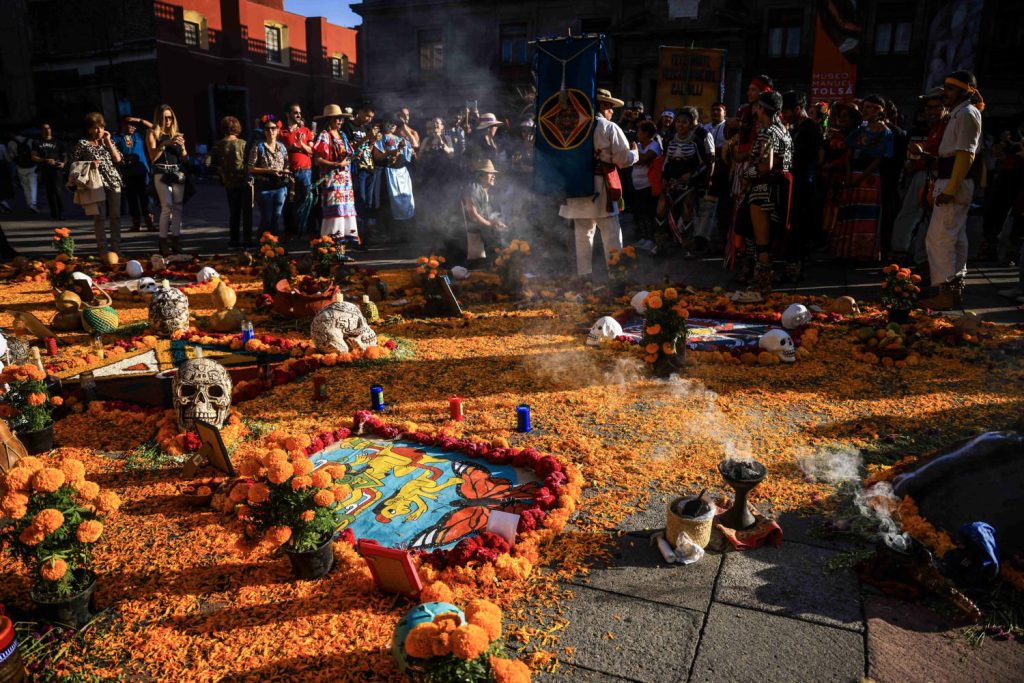Día de los Muertos in Mexico: A Celebration of Life and Remembrance
Día de los Muertos, or Day of the Dead, is one of Mexico’s most profound and colorful traditions. Far from a somber affair, it is a joyous celebration of life and a heartfelt tribute to loved ones who have passed on. For those unfamiliar, Día de los Muertos blends indigenous rituals with Catholic traditions, creating a unique cultural event that spans two days—November 1 (Día de los Inocentes, honoring deceased children) and November 2 (Día de los Muertos, for adults).
During my time in Mexico, I had the privilege of experiencing this extraordinary celebration firsthand. Here’s a glimpse into its beauty, symbolism, and the deeply emotional moments I encountered.
1. The Heart of Día de los Muertos: Ofrendas
Central to the celebration are ofrendas, altars lovingly created in homes, cemeteries, and public spaces. Each ofrenda is a masterpiece, decorated with photos of the departed, marigold flowers (cempasúchil), candles, and personal mementos. Every element carries meaning:
- Marigolds: Known as the “flower of the dead,” their vibrant orange and yellow hues are believed to guide spirits back to the living world.
- Candles: Each flame represents the soul of a departed loved one.
- Food and Drink: Favorites of the deceased, such as tamales, mole, or tequila, are offered to welcome them back.
- Sugar Skulls: These decorative skulls symbolize the sweetness and inevitability of life and death.
I was deeply moved by how much care families put into their ofrendas. In Oaxaca, I saw altars that took days to assemble, each detail telling a story of love and remembrance.
2. Cemeteries: Places of Connection
On the nights of Día de los Muertos, families gather at cemeteries to honor their loved ones. I joined a family in the town of Mixquic, just outside Mexico City, where the cemetery transformed into a vibrant space filled with laughter, music, and candlelight.
Graves were adorned with marigolds, and families shared meals as they reminisced. Children played among the tombstones, and musicians performed songs that the deceased once loved. The atmosphere was one of reverence, yet it brimmed with life and celebration—a poignant reminder that death is not the end but a continuation of the journey.
3. Festivities in Oaxaca and Beyond
Oaxaca: A Cultural Epicenter
Oaxaca is one of the best places to experience Día de los Muertos. The city comes alive with parades, traditional dances, and elaborate sand tapestries called tapetes de arena. The streets were lined with papel picado (colorful paper banners), and every corner seemed to host a celebration.
One of the most unforgettable moments was joining a comparsa, a lively parade of people in skeleton costumes and face paint, dancing to the rhythm of brass bands. I even had my face painted in the iconic calavera style, a visual representation of embracing mortality.
Janitzio Island, Michoacán
In Michoacán, the celebration takes on a spiritual tone, especially on Janitzio Island. I witnessed candlelit canoes gliding across Lake Pátzcuaro, creating a mesmerizing display. The Purépecha community’s rituals, steeped in ancient tradition, offered a deeply moving perspective on honoring the dead.
4. Food and Drink: A Taste of Tradition
No celebration in Mexico is complete without food, and Día de los Muertos is no exception. I indulged in:
- Pan de Muerto: A sweet bread sprinkled with sugar, often shaped like a skull or bones. It’s as delicious as it is symbolic.
- Atole: A warm, comforting drink made from masa (corn dough), flavored with cinnamon and vanilla.
- Tamales and Mole: Traditional dishes that vary by region but always delight the taste buds.
Sharing these meals with locals added to the sense of community and connection that defines Día de los Muertos.
5. Lessons from Día de los Muertos
Día de los Muertos isn’t about mourning—it’s about celebrating life and remembering with joy. This perspective on death, as a natural and even beautiful part of existence, challenged and enriched my own views.
The festival also reminded me of the power of community. Families, friends, and neighbors come together to honor the past, strengthening bonds in the present.
6. Tips for Experiencing Día de los Muertos
- Plan Ahead: Popular destinations like Oaxaca, Michoacán, and Mexico City attract many visitors, so book accommodations and transportation early.
- Participate Respectfully: This is a deeply personal celebration. Observe with humility and avoid treating it as a spectacle.
- Try Face Painting: Join the festivities by having your face painted in the traditional calavera style—it’s a meaningful way to connect with the celebration.
- Learn the Traditions: Take time to understand the symbolism behind the ofrendas, foods, and rituals.
- Visit Different Locations: Each region of Mexico has its unique way of celebrating, offering a diverse experience.
Conclusion
Día de los Muertos is more than just a holiday—it’s a profound celebration of love, memory, and the unbreakable bond between the living and the dead. Experiencing it in Mexico was a privilege that left me with a deeper appreciation for life’s fleeting beauty and the importance of cherishing every moment.
If you ever have the chance to witness Día de los Muertos, embrace it fully. You’ll leave with unforgettable memories and perhaps a new perspective on life and death.

